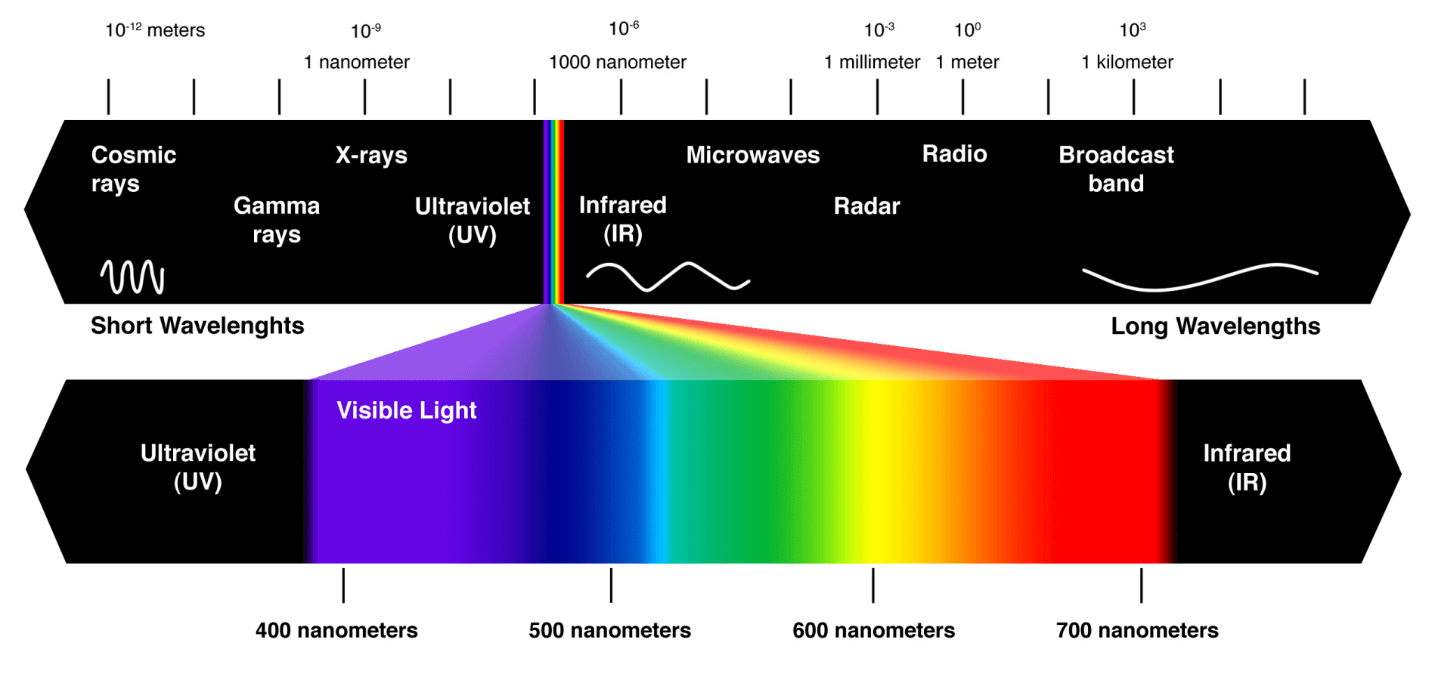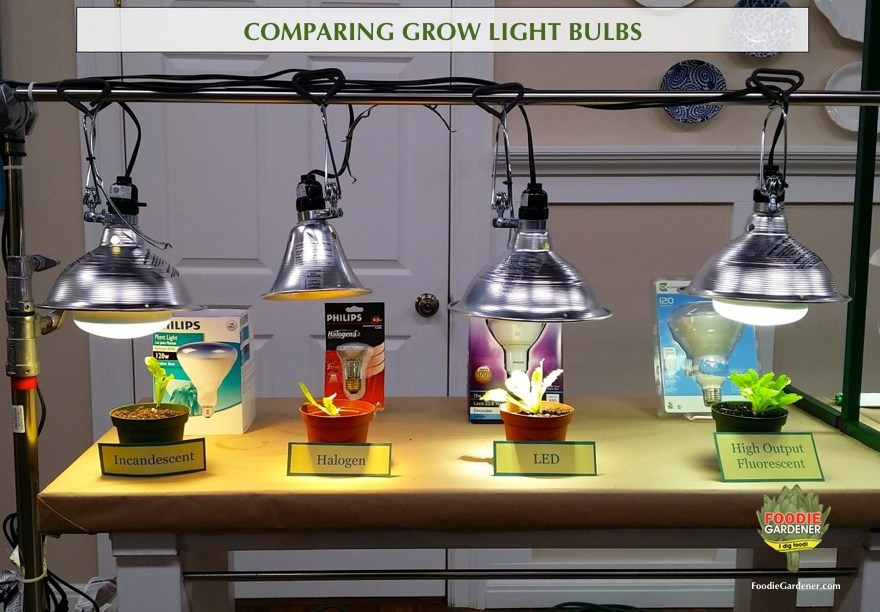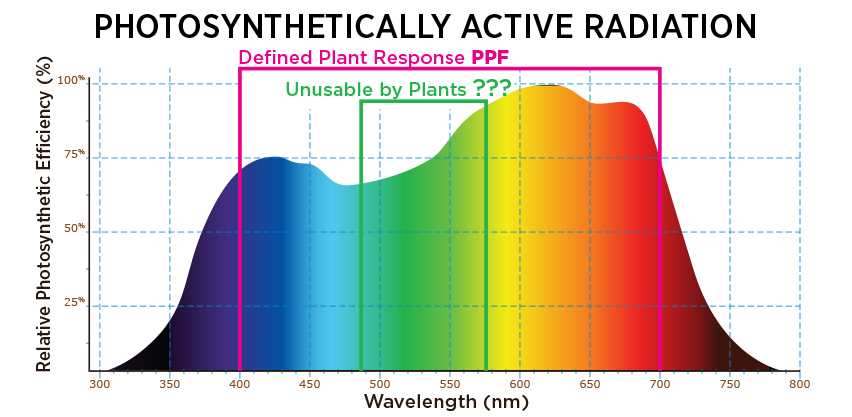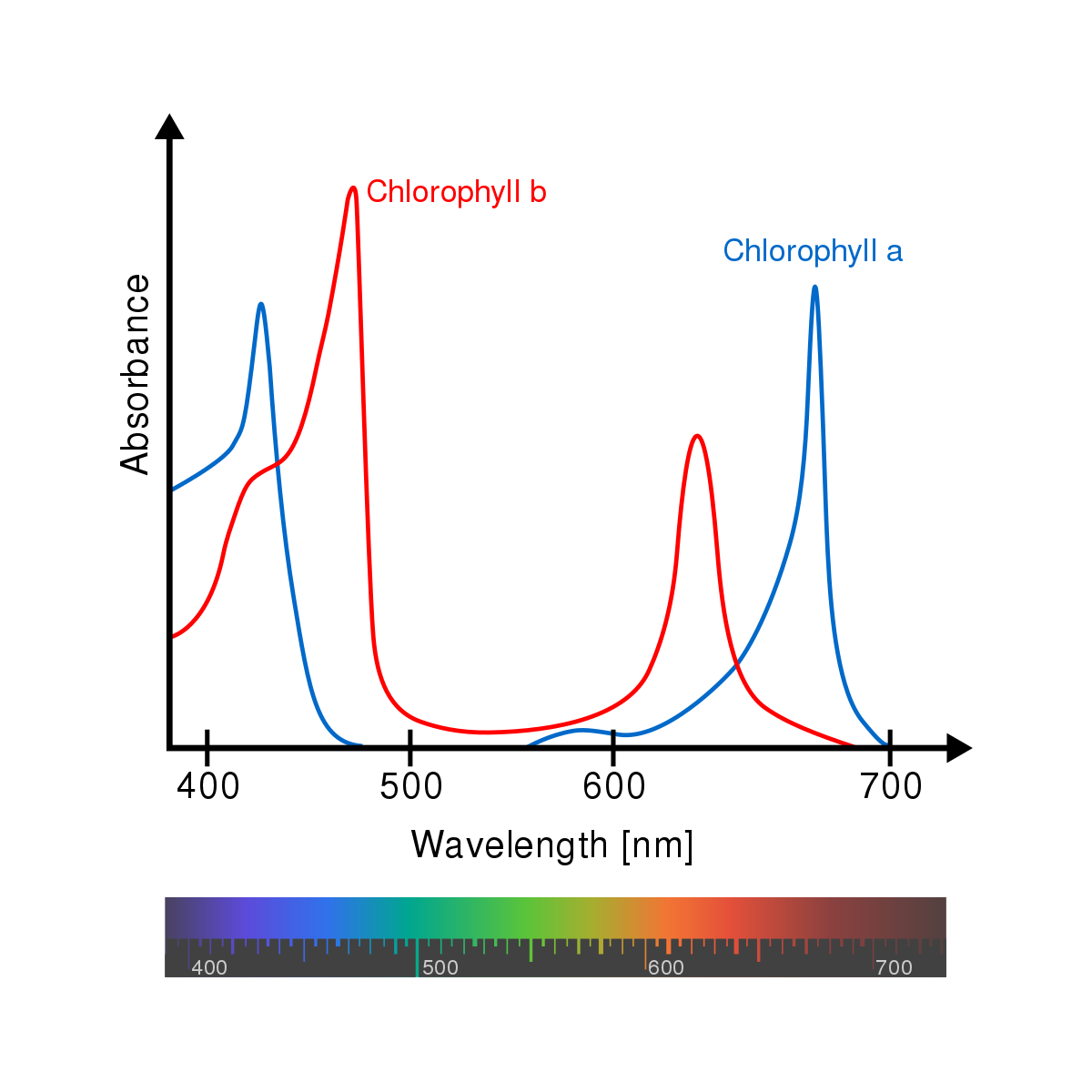What Is The LED Grow Ligh Spectrum? -- The Relationship Between Plant Growth And Spectrum
Writer:Jane Time:2020-12-10 Browse:134
Choosing the right LED plant light spectrum for your houseplant is a key to success or failure. Due to the lack of plant and lighting research knowledge, many LED planting lamp suppliers lack the ability to conduct professional research on this issue and apply it to their actual products.
In this article, we will analyze what spectrum is, how plants respond to light and how spectrum affects plant growth.
What is plant light spectrum?
The spectrum is the range of wavelengths produced by the light source. In discussing spectrum, the word "light" refers to the visible wavelength of the electromagnetic spectrum that one can see from 380 to 740 nanometers (nm). Ultraviolet (100-400 nm), far-infrared (700-850 nm), and infrared (700-106 nm) wavelengths are called radiation.
As growers, we are most interested in the wavelengths associated with the plant. The wavelengths of plant detection include ultraviolet (260 -- 380 nm) and the visible part of the spectrum (380 -- 740 nm), including PAR(400 -- 700 nm) and far-infrared radiation (700 -- 850 nm).
Greenhouse and indoor environments will differ when considering the spectrum of horticultural applications. In an indoor environment, your growth spectrum will account for the proportion of the total spectrum received by the crop. In a greenhouse, you must take into account that your plant is receiving a combination of growth light and the solar spectrum.
Either way, the amount of each band your crop receives can have a major impact on growth. Let's take a closer look at how it works.

The essence of spectrum - electromagnetic waves of different wavelengths
PAR- Photosynthesis available spectrum of plants, mainly the 400-700nm part
How do plants respond to light?
Plants use light for photosynthesis and photomorphogenesis. Photosynthesis is the process by which plants and other living things convert light energy into chemical energy. Photomorphogenesis refers to how a plant changes its growth in response to the spectrum.
An example of photomorphogenesis is a plant that is bent toward the light source. Light also affects the developmental stages of a plant, such as germination and flowering.
The light range that plants use primarily for photosynthesis is 400 -- 700 nm. This range is called photosynthetically active radiation (PAR) and includes red, blue, and green wavelengths.
The light morphology occurs over a wide range of about 260-780 nm, including ultraviolet and far infrared radiation.
The absorption spectra of chlorophyll a and b
Chlorophyll a and b are the main photosynthetic pigments of plants. It is important to note that chlorophyll absorbs the most red light (600-700 nm) and blue light (400-500 nm), and the least green light (500-600 nm). Still, photosynthesis is a more complex process than simple chlorophyll absorption and involves other chemicals whose interactions with the spectrum are still well understood.
What effects can spectrum have on plant growth?
Plants have photoreceptors which can trigger different growth characteristics when activated by photons of specific wavelengths. Thus, by controlling the spectrum, you can influence powerful changes in plant growth.
The growth characteristics that can be affected by the spectrum are listed below:
1. Bear fruit
2. Flowering yield
3.Growth rate
4. The fresh weight
5. Compact
6. Root development
7. Plant health
8.Color
9. The taste
10.Nutrition
It is important to note that using the spectrum to activate the plant response is an integral part of a larger process, and the results are largely dependent on many factors, such as light intensity, photoperiod, growing environment, plant species, and even plant species.
How does each spectrum affect plant growth?
Although the results depend on other factors, you can follow general rules of thumb when using spectra to elicit different plant reactions.
The following Outlines how to use each band for horticultural purposes so that you can try out spectral strategies in your own growing environment as well as in the crop variety of your choice.
Ultraviolet wavelength (100-400 nm)
The UV band is not outside the PAR band and may provide new applications for horticulture that have not yet been clearly defined.
The most obvious thing to think of is the effects of ultraviolet radiation on human health. As we all know, prolonged exposure to UV rays can cause sunburn, while short exposures usually result in a sunburn. In this respect, plants and humans respond similarly to ultraviolet light.
Like people, plants can be damaged by exposure to ultraviolet radiation. Plants also naturally produce protective compounds that reduce tissue damage from UV rays. In response to ultraviolet light, plants may become darker or more purplish. Studies have shown that UVB light can increase the content of essential oils and phenolic compounds in certain herbal species.
UV potential includes increasing leaf color and thickness, as well as resistance to environmental stress, pests and fungi. The amount of UV required to achieve these potential benefits has not been clearly defined. In addition, the risks associated with UV rays have not been well quantified.
Blue wavelength (400-500 nm)
Blue light has obvious effect on the growth and flowering of plants. In general, blue light can improve the overall plant quality of many green leaf and ornamental plants.
The minimum amount of blue light is required to maintain normal plant development. In terms of tunable spectral lighting strategies, if we equate red light with your car engine, then blue light would be the steering wheel.
When used in combination with other spectral bands, blue light can promote plant densification, root development and production of secondary metabolites. Blue light can be used as a growth regulator to reduce the need for growth regulators (PGR) in chemical plants. Blue light can also improve the overall health of plants by increasing the accumulation of chlorophyll and opening of stomata (facilitating gas exchange).
One example of how blue light affects secondary plant metabolites is how blue bands promote the growth of anthocyanins in leaves and flowers. Elevated anthocyanin levels lead to more pronounced colors.
Blue light also promotes other secondary metabolic compounds associated with improved flavor, aroma, and taste. For example, blue light treatment has been shown to improve terpene retention in some cannabis varieties.
High intensity blue light (> 30μmol·m-2·s-1) inhibited or promoted the flowering of plants sensitive to day length. Blue light does not regulate flowering at low light intensity (<30μmol·m-2·s-1) and is therefore safe to use at night to affect the other plant characteristics listed above
Green light wavelength (500 -- 600 nm)
Since chlorophyll does not absorb green light as easily as other wavelengths, many people write off the green wavelengths because they are less important for plant growth. This low chlorophyll absorption gives most plants a green color compared to blue and red light. Leaves typically reflect between 10 and 50 percent of the green band of photons, depending on the plant.
Contrary to the hypothesis, studies of green light in crop production have concluded that green light is important for photosynthesis, especially in the lower leaves of plants. About 80 percent of the green light is transmitted through the chloroplasts, while leaves absorb about 90 percent of the light and transmit less than 1 percent of the red and blue light.
So what does this mean? When light is abundant, chlorophyll reaches saturation point and no longer absorbs red and blue light. However, green light can still excite electrons in chlorophyll molecules deep in the leaves or in chloroplasts in the lower canopy of the plant. Therefore, green light can increase the efficiency of photosynthesis under strong light conditions, which may increase the yield of crops.
In addition, the ratio of green, blue, and red wavelengths signals to the plant the crown position of the leaves. This can cause morphological changes to maximize light absorption. Green light also plays a role in regulating stomatal aperture (the opening and closing of plant pores that make gas exchange possible).
Greenhouse applications require less supplemental green light because plants will receive enough green light from solar radiation. Since sunlight is not present, indoor environments may benefit from supplementing green light.
Red wavelength (600 -- 700 nm)
Red light is one of the most effective bands to stimulate photosynthesis and promote the growth of plant biomass.
Plants that grow only in red light tend to grow elongated and tall with thin leaves - an undesirable way to grow. But adding the right amount of blue light to balance out red light can make plants more compact and have thicker leaves.
Therefore, it is always important to consider the many ways in which light at different wavelengths can interact, rather than relying on just one wavelengths to develop plants healthily.
Far red wavelength (700 -- 850 nm)
Far red light is located at the far end of the red spectrum between 700 and 850 nm. Plants were found to respond to wavelengths up to 780 nm. Recently, attention and research related to the increased far-infrared light and the potential to control growth have received increasing attention.
Far red light causes avoidance, which leads to stretching and stretching (see below for more information on light avoidance). Far-infrared light also promotes the flowering and leaf expansion of long-day plants, thus increasing the available surface area for capturing photons for photosynthesis. It has also recently been reported that far infrared can improve the efficiency of PAR bands associated with photosynthesis.
It is important to consider how a class of photoreceptors, plant pigments, perceive the ratio of red to far-infrared radiation (R: Fr). Pigment-mediated regulation in plants is a complex process that may have a profound effect on elongation and flowering. The ratio of blue to red light also affects how plants respond to far-red radiation.
What is the avoidance reaction?
In nature, sunlight contains almost as much far-red light (20%) as red light (21%). Leaves at the top of the canopy are most exposed to sunlight and tend to absorb red light when reflecting or transmitting most of the far red light.
As a result, leaves with lower canopies can use less red light and receive a higher proportion of far-infrared light. This relatively low reddish to far-red ratio triggers the stem to stretch, the leaves to stretch to block more sunlight. Supplementary LED lighting can cause this reaction.
Because of the stretching response of plants to far-red light, growers who would benefit from more compact growth must be careful to add far-red to their lighting regimens. When adding far-red light to your lighting formula, be sure to consider the ratio of far-red light to other bands and crop types.
Although scientists don't fully understand how far-infrared light alters plant growth, it plays a crucial role in the efficiency of photosynthesis. The concept of the "Emerson effect" is that two photosystems work together to optimize electron transport and photosynthetic rates, with one most sensitive to photons at 680 nm and one most sensitive to photons at 700 nm (up to 850 nm in the far infrared). These systems are synergistic, that is, their combined contribution to photosynthesis is greater than the sum of their respective contributions. Other research may find the best way to deploy distal red in different crop types and varieties.
How to choose the most suitable spectrum according to the plant variety?

Using the above guidelines, growers can use smart horticultural lighting software to properly adjust the way their crops respond when adjusting the growth light spectrum ratio.
In conclusion, we see that the following applications of spectrum in horticulture are common:
Red lights: More red lights tend to cause more biomass growth and extension. Red light is commonly used to expand plants early in development or to stretch plants when longer internode intervals are needed.
Blue light: A higher percentage of blue light is a powerful tool for improving plant quality. When more blue light is present, it usually improves biochemical processes leading to better nutrition, color, root development and overall quality. Deploying a higher proportion of blue light usually means a reduction in the total PPFD to the crop, so these strategies should be used strategically and carefully.
Green lights: We know that green lights are important for photosynthetic efficiency and plant development, although these processes are still being explored. Adding and supplementing green light is most important when sunlight does not provide enough green light for crops. The best pink LED plant growth lights take this into account and provide plenty of green in their pink spectral range.
It is not possible to provide a complete list of photomorphogenesis processes for all plant species, so we recommend that you run spectral trials in a research and development space before applying spectral strategies in a production environment.
Pan American also offers some of the latest plant and light research, so you can apply proven spectral strategies to your commercial applications.
Excited about the possibilities, but still not sure how to get started? Please contact us, we are happy to help you!



